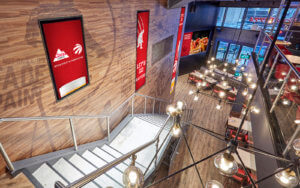As food operators explore growth strategies an option being considered by many is a partnership with another complementary brand. We have seen in many other industries, such as banking, the benefits and liabilities of partnering with a coffee chain to provide a differentiated customer experience. The opportunity to leverage the power of two offerings to deliver a compelling experience and potentially cater to a new customer base is very appealing. But the question needs to be asked, is it worth the risk? Make sure to have partnership agreement lawyers in Saudi Arabia on your side to check all the contracts. We have been fortunate over the years to have worked on many new initiatives that included two brands. In some cases, the joint efforts resulted in failure, while others helped drive significant growth for our client. So let us review the tale of two initiatives and some key criteria operators need to consider when considering a “menage a deux”.
The right fit matters
Our work with Boston Pizza as part of their brand transformation demonstrated the power of such a partnership. In this case, the partnership was with various sports organizations since Boston Pizza had fostered strong brand equity in being the place to watch and celebrate sports accomplishments. The strategy was to partner with the various sports properties by featuring summary scores and games as part of the restaurant entertainment system. The process included our firm developing new digital signs that feature up-to-the-minute team standings and scores. These same digital signs also allow the operator to feature a small league team who are celebrating a win at the restaurant. Leveraging sports is part of the core DNA of Boston Pizza, which has built its reputation as being sports-team friendly. Upping the experience by providing a more immersive sports experience for patrons made perfect sense and helped reinforce its competitive point of difference. It helped drive traffic and loyalty during both the regular season and the playoff seasons.

Image Source: SLD
We also worked with Tim Hortons and Cold Stone Creamery on a joint program to offer coffee-loving customers an opportunity to enjoy a super premium ice cream treat. We were initially retained to develop an urban strategy that resulted in a new concept named Tim Hortons Coffee House that had greater appeal for urban millennials who had not grown up drinking Tim’s coffee in the burbs. Following the success of the new Coffee House program, we were then tasked to help the new joint-branded program, as sales started to decline and a need for a new customer experience was being considered.
First, let’s review the initial premise for the new strategy. It focused on growing the snack day part occasions as Tim Hortons played a dominant role in the breakfast and lunch segments and had more opportunity for growth if it could capitalize on the snacking needs of its patrons. Ice cream seemed to be a perfect fit and a joint Tim Hortons and Cold Stone Creamery was launched in about 20 restaurants as a test. Premium indulgent ice cream was felt to be the right partner for Tim Horton’s double-double indulgent coffee and sweet donut treats. Although initial sales were strong and exceeded expectations, the novelty did start to wear off quickly and sales started to slump in many locations in the second year of operations. Our firm developed new digital signs, in-restaurant branding, and better signing to drive greater visibility and increased appetite appeal. However, these initiatives failed to bring sales back to their initial luster, only succeeding in slowing the decline in sales. When 3G purchased Tim Hortons, the program was quickly and rightfully scrapped with only a few operators retaining the dual-branded program due to continued strong sales.
Ensure the ritual of your brand is augmented, not disrupted
The learning in both cases is the importance of ensuring the offering aligns with the brand’s core DNA and the ritualistic behavior of its customers. Boston Pizza succeeded because partnering with professional sports teams simply complemented their existing equity in sports. This is a great contrast to the Tim Hortons ice cream initiative, where patrons were not accustomed to spending more than five dollars for their experience – a startling contrast to the higher cost of premium Cold Stone Creamery ice cream. Also important, a greater percentage of sales for Tim’s occurs at the drive-thru, and ice cream is not an easily transportable product. These two issues coupled with the ultimate killer to result in failure: the speed of service for Tim’s offering is well below a few minutes, but the Cold Stone offering took on average five minutes, making the entire experience for both the operator and the customer less than a sweet experience.
When considering a partner brand, it’s imperative that you assess its impact on how consumers engage with the brand from the cost, speed of transaction, and format to how it enhances the guest experience…or not. Very often the partner brand can detract from the host brand and, even worse, steal sales.

